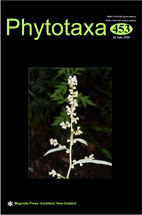Abstract
Two new species of Manihot endemic to the Amazon region are described here: Manihot australis and M. striata. Important diagnostic characters distinguishing the new species such as presence or absence of indumentum, form and size as well presence or absence of ribs in fruits, among other, are discussed and illustrated by line drawings and photographic plates. Information about their natural habitat and distribution is also provided.
References
Allem, A. (1999) A new species of Manihot (Euphorbiaceae) from the Brazilian Amazon. International Journal of Plant Sciences 160: 181–187.
<a href="https://doi.org/10.1086/314102">https://doi.org/10.1086/314102</a>
Cervantes-Alcayde, M., Olson, M.E., Olsen, K.M. & Eguiarte, L.E. (2015) Apparent similarity, underlying homoplasy: Morphology and molecular phylogeny of the North American clade of Manihot. Americam Journal of Botany 102: 520–532.
<a href="https://doi.org/10.3732/ajb.1500063">https://doi.org/10.3732/ajb.1500063</a>
Loefling, P. (1758) Iner Hispanicum; eller, Resa til spanska länderna uti Europa och America förrättad ifrån år 1751 til år 1756. Utgifven af Carl Linnæus, Stockholm, 316 pp.
Mendoza, F.J.M. (2009) Especies de la familia Euphorbiaceae, Género Manihot, Libro Rojo de parientes silvestres de cultivos de Bolivia. Plural editores, La Paz, Bolivia, pp. 135–153.
Mendoza, F.J.M. (2010) Los parientes silvestres del cultivo de la yuca en Bolivia: Estado de conocimiento, Grado de conservación y Acciones de conservación propuestas. Imprenta Sagitario. La Paz, Bolivia, 166 pp.
Mendoza, F.J.M., Simon, M.F., Arquelão, T.K.M. & Cavalcanti, T.B. (2018) Novas espécies de Manihot (Euphorbiaceae) do Brasil Central. Rodriguésia 69: 915–932.
<a href="https://doi.org/10.1590/2175-7860201869244">https://doi.org/10.1590/2175-7860201869244</a> Miller, P. (1754) The gardeners Dictionary, 4th Ed.Vol. 2. London.
Müller Argoviensis, J. (1866) Euphorbiaceae excl. Euphorbieae. In: Candolle, A.L.P.P. (Ed.) Prodromus Systematis Naturalis Regni Vegetabilis 15 (2). Treuttel & Würtz, Paris, pp. 189–1260.
Müller Argoviensis, J. (1874) Manihot in Flora Brasiliensis, 11. pp. 1269–1286.
Pax, F. (1910) Euphorbiaceae-Adrianeae. In: A. Engler (Ed.) Das Pflanzenreich, Regni Vegetabilis. Conspectus IV. 147 II. Heft 44. pp. 21–99.
Pohl, J.B.E. (1827) Plantarum Brasiliae Icones et Descriptiones 1. A.Strauss, Wien, 134 pp.
Rogers, D.J. & Appan, S.G. (1973) Manihot and Manihotoides (Euphorbiaceae). Flora Neotropica Monograph 13. Hafner Press, New York, 272 pp.
Ruiz, H. & Pavón, J.A. (1789) Systema Vegetabilium Florae Peruvianae et Chilensis. Typis Gabrielis de Sancha, 456 pp.
Thiers, B. [continuously updated] Index Herbariorum: A global directory of public herbaria and associated staff. New York Botanical Garden’s Virtual Herbarium. [http://sweetgum.nybg.org/science/ih/]
Wendland, H. (1860) Bermerkungen über einige Palmengattungen Amerika’s. Bonplandia 8: 100–106.
<a href="https://doi.org/10.1086/314102">https://doi.org/10.1086/314102</a>
Cervantes-Alcayde, M., Olson, M.E., Olsen, K.M. & Eguiarte, L.E. (2015) Apparent similarity, underlying homoplasy: Morphology and molecular phylogeny of the North American clade of Manihot. Americam Journal of Botany 102: 520–532.
<a href="https://doi.org/10.3732/ajb.1500063">https://doi.org/10.3732/ajb.1500063</a>
Loefling, P. (1758) Iner Hispanicum; eller, Resa til spanska länderna uti Europa och America förrättad ifrån år 1751 til år 1756. Utgifven af Carl Linnæus, Stockholm, 316 pp.
Mendoza, F.J.M. (2009) Especies de la familia Euphorbiaceae, Género Manihot, Libro Rojo de parientes silvestres de cultivos de Bolivia. Plural editores, La Paz, Bolivia, pp. 135–153.
Mendoza, F.J.M. (2010) Los parientes silvestres del cultivo de la yuca en Bolivia: Estado de conocimiento, Grado de conservación y Acciones de conservación propuestas. Imprenta Sagitario. La Paz, Bolivia, 166 pp.
Mendoza, F.J.M., Simon, M.F., Arquelão, T.K.M. & Cavalcanti, T.B. (2018) Novas espécies de Manihot (Euphorbiaceae) do Brasil Central. Rodriguésia 69: 915–932.
<a href="https://doi.org/10.1590/2175-7860201869244">https://doi.org/10.1590/2175-7860201869244</a> Miller, P. (1754) The gardeners Dictionary, 4th Ed.Vol. 2. London.
Müller Argoviensis, J. (1866) Euphorbiaceae excl. Euphorbieae. In: Candolle, A.L.P.P. (Ed.) Prodromus Systematis Naturalis Regni Vegetabilis 15 (2). Treuttel & Würtz, Paris, pp. 189–1260.
Müller Argoviensis, J. (1874) Manihot in Flora Brasiliensis, 11. pp. 1269–1286.
Pax, F. (1910) Euphorbiaceae-Adrianeae. In: A. Engler (Ed.) Das Pflanzenreich, Regni Vegetabilis. Conspectus IV. 147 II. Heft 44. pp. 21–99.
Pohl, J.B.E. (1827) Plantarum Brasiliae Icones et Descriptiones 1. A.Strauss, Wien, 134 pp.
Rogers, D.J. & Appan, S.G. (1973) Manihot and Manihotoides (Euphorbiaceae). Flora Neotropica Monograph 13. Hafner Press, New York, 272 pp.
Ruiz, H. & Pavón, J.A. (1789) Systema Vegetabilium Florae Peruvianae et Chilensis. Typis Gabrielis de Sancha, 456 pp.
Thiers, B. [continuously updated] Index Herbariorum: A global directory of public herbaria and associated staff. New York Botanical Garden’s Virtual Herbarium. [http://sweetgum.nybg.org/science/ih/]
Wendland, H. (1860) Bermerkungen über einige Palmengattungen Amerika’s. Bonplandia 8: 100–106.

